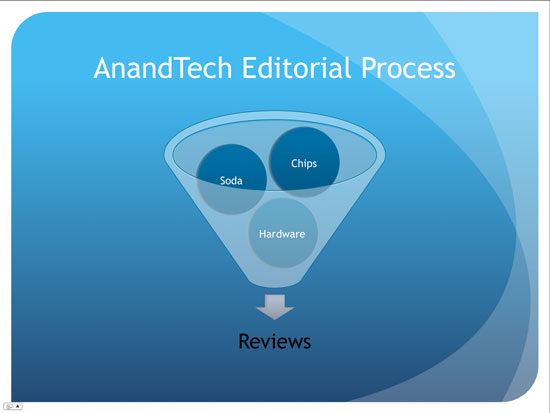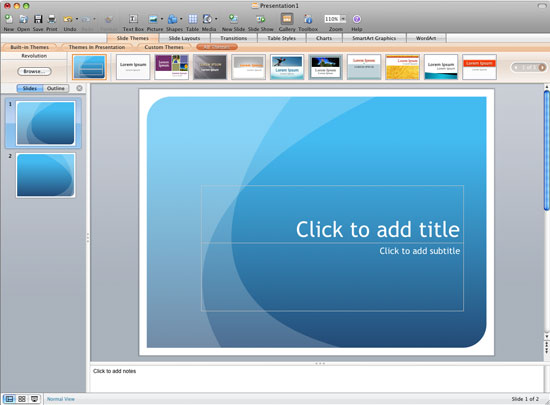The Other Office: Microsoft Office 2008 for Mac Review
by Ryan Smith on February 5, 2008 12:00 AM EST- Posted in
- Mac
Excel & PowerPoint
Next to Word, the rest of the core Office applications have not received the same kind of attention, with Microsoft clearly not having a clear goal for these applications like they did Word.
Excel is the most neglected, having gained very little and suffering the most from the loss of VBA. Excel’s big new feature for Office 2008 is ledger sheet templates, functioning as Excel’s version of Word’s publishing layout templates. These various ledger templates are pre-formatted to feature the types of columns appropriate for the ledger type, and any formulas such a ledger would need. Even more so than the Word page layout features, the ledger templates are clearly targeted towards home users and not business users.
Filling out Excel’s ribbon are WordArt, SmartArt, and the new charts. Office’s new charting abilities have more of a chance to shine here, as Excel is free of the uncomfortable bond between itself and Word when charts are summoned through Word. It’s hard to get particularly excited about a chart of all things, but Microsoft’s art team deserves credit here for coming up with some nice, modern graphics for charts in Office 2008 that are far better than some of the tired and blocky charts of Offices past.

Last but not least among the core Office applications is PowerPoint, which has found itself in an odd bind on the Mac in recent years. Since 2003 Apple has published its own presentation software, Keynote, the brainchild and reportedly favorite piece of Apple software for Steve Jobs. When visual flare is one of Apple’s strongest suits, Keynote is easily the biggest competitor to any single Office component on the market. Apple has put in every trick in the book in to Keynote, from OpenGL accelerated effects to integration with Apple’s media applications.
The bind for PowerPoint is trying to once again push PowerPoint ahead of Keynote; unlike word processing documents and spreadsheets, there’s little need to widely share presentations, which means Microsoft can’t bank on the fact that PowerPoint is still more popular because it’s also on Windows. Here the problem isn’t so much one of functionality but visuals, keynote is functionally very similar but gets such heavy usage on the Mac due to its superior visuals.
As a result and as has been the case with the rest of Office 2008, the changes for PowerPoint 2008 start with templates and artwork, many of the old templates have been thrown out and many more new ones introduced that stay with the theme of modernizing the graphics in Office and beating Apple at visual flare. The transitions have also been updated with the addition of several new transitions, including a few 3D transitions. Unfortunately for Microsoft they still aren’t using OpenGL here, which limits what they can further do with transitions; even a number of Keynote’s 2D transitions are using some kind of OpenGL effect that demonstrate so well Apple’s goal for visual flare. And while it seems petty to complain about PowerPoint’s transitions of all things, our own real world experience is that a showy transition may be the last thing keeping the audience drifting away, so at some level they do count.

A 3D cube transition midway through transition
SmartArt rounds out the major changes in PowerPoint’s visuals, and while it’s technically available in all 3 core Office applications it makes far more sense to discuss it here since its predominant use will be in PowerPoint. As we called it earlier, SmartArt is a series of simple & stylized diagramming elements that are used to show the relationships between data. PowerPoint has come with its own minimal flowchart/diagramming abilities for years (for more complex charting is Microsoft’s Visio, which isn’t on the Mac) but SmartArt isn’t a replacement or competitor for that functionality. Rather SmartArt’s pre-built diagrams serve to offer better looking diagrams that only need their text plugged in; in essence faster & shiner diagramming for a limited number of common cases.
Given how obtuse (and ugly) PowerPoint’s prior diagramming abilities were, we’d consider SmartArt a useful and meaningful addition to PowerPoint, with enough variety to keep from audiences getting too burnt out on the artwork too soon. It’s also one of the few things that will set PowerPoint 2008 apart from Keynote for now, although we’d bet on Apple introducing its own SmartArt implementation if it proves to be as useful as we suspect it to be.

PowerPoint has also received a
few new pieces of functionality, largely bringing it up to par with Keynote in
areas where it was lacking. PowerPoint now features some iPhoto integration,
allowing slideshows to be exported to iPhoto for distribution to users without
PowerPoint, or alternatively to iPods which can function as presentation
devices when a video-out kit is attached (obviously not with the special
effects, however). The Apple Remote is also supported now, giving PowerPoint
another option for controlling their presentations.












13 Comments
View All Comments
corporatecookie - Tuesday, February 5, 2008 - link
Remember Outlook 2001 for Mac ..alasknitecrow - Tuesday, February 5, 2008 - link
I find myself using office 2007 a lot more under FusionLocutus465 - Tuesday, February 5, 2008 - link
it seems like office 2007 is built more around extensability through .Net, will '08 for mac support this in lue of VBA? I guess this would require excellent support for .net on the mac platform.